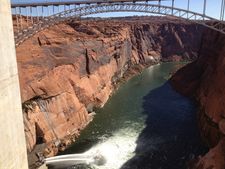Difference between revisions of "A 2021 Fall HFE"
Cellsworth (Talk | contribs) (Created page with " {{Infobox Person |name = High Flow Experiment- 2021 |image = CRC 121119 0038.JPG |alma_mater = |Job Title = |Previous_Title_ = |Previous_Title_ =...") |
Cellsworth (Talk | contribs) |
||
| Line 15: | Line 15: | ||
== 2021 Fall High Flow Experiment Snapshot == | == 2021 Fall High Flow Experiment Snapshot == | ||
*A 2021 Fall HFE was not conducted | *A 2021 Fall HFE was not conducted | ||
| + | |||
| + | A November 2021 High Flow Experiment is being considered by the Glen Canyon Dam Planning and Implementation Team. In early October, the Secretary of the Interior (or her Designee) will decide whether to implement a fall HFE following careful consideration of the Team's technical recommendation. | ||
| + | |||
| + | Under the 2016 Long-Term Experimental and Management Plan Record of Decision, HFE releases are triggered by substantial sediment accumulation in the Colorado River below Glen Canyon Dam. Monsoonal flooding in the Paria River near Lees Ferry moves sediment into the Colorado River, where its accumulation is carefully monitored by the U.S. Geological Survey. When implemented, high flows carry and redistribute the sediment throughout the canyon above the typical high-water mark. | ||
| + | |||
| + | Per the 2016 ROD, HFEs releases can occur either in the spring from March through June (spring HFE), or in the fall from October through November (fall HFE). If enough sediment enters the Colorado River from July to November, a fall HFEs release can be implemented. The decision to conduct a fall HFE release is usually made in October based on sediment accumulation, as well as a variety of other resource conditions. | ||
| + | |||
| + | No HFEs were conducted in calendar year 2019 or 2020, though a Spring Disturbance Flow was implemented in March 2021. The Department of the Interior conducted the most recent HFE release from Glen Canyon Dam on November 5-8, 2018. The HFE release included a peak flow of approximately 38,100 cubic feet per second for 60 hours (four days including ramping-up from baseflows to peak release) to move accumulated sediment downstream to help rebuild beaches and sandbars. This HFE release was the first to be conducted under the 2016 LTEMP HFE Protocol. Similar HFE releases were conducted in 2012, 2013, 2014 and 2016 in accordance with the 2011 HFE Environmental Assessment Protocol. The 2018 HFE release provided resource benefits and scientific information to be used in future decision making. [https://www.usbr.gov/uc/rm/gcdHFE/index.html] | ||
==Sediment Conditions== | ==Sediment Conditions== | ||
Revision as of 15:24, 20 October 2021
| High Flow Experiment- 2021 | |
 |
Contents
2021 Fall High Flow Experiment Snapshot
- A 2021 Fall HFE was not conducted
A November 2021 High Flow Experiment is being considered by the Glen Canyon Dam Planning and Implementation Team. In early October, the Secretary of the Interior (or her Designee) will decide whether to implement a fall HFE following careful consideration of the Team's technical recommendation.
Under the 2016 Long-Term Experimental and Management Plan Record of Decision, HFE releases are triggered by substantial sediment accumulation in the Colorado River below Glen Canyon Dam. Monsoonal flooding in the Paria River near Lees Ferry moves sediment into the Colorado River, where its accumulation is carefully monitored by the U.S. Geological Survey. When implemented, high flows carry and redistribute the sediment throughout the canyon above the typical high-water mark.
Per the 2016 ROD, HFEs releases can occur either in the spring from March through June (spring HFE), or in the fall from October through November (fall HFE). If enough sediment enters the Colorado River from July to November, a fall HFEs release can be implemented. The decision to conduct a fall HFE release is usually made in October based on sediment accumulation, as well as a variety of other resource conditions.
No HFEs were conducted in calendar year 2019 or 2020, though a Spring Disturbance Flow was implemented in March 2021. The Department of the Interior conducted the most recent HFE release from Glen Canyon Dam on November 5-8, 2018. The HFE release included a peak flow of approximately 38,100 cubic feet per second for 60 hours (four days including ramping-up from baseflows to peak release) to move accumulated sediment downstream to help rebuild beaches and sandbars. This HFE release was the first to be conducted under the 2016 LTEMP HFE Protocol. Similar HFE releases were conducted in 2012, 2013, 2014 and 2016 in accordance with the 2011 HFE Environmental Assessment Protocol. The 2018 HFE release provided resource benefits and scientific information to be used in future decision making. [1]
Sediment Conditions
Winter Accounting Period
- Paria input (Jul 1 to Nov 30):
- Evacuated from Upper Marble Canyon (Jul 1 to Nov 30, lower bound) =
- Evacuated from Lower Marble Canyon (Jul 1 to Nov 30, lower bound) =
- Available for Fall HFE:
SUPPORTING DOCUMENTS
COMPLIANCE
CONCERNS
ADDITIONAL